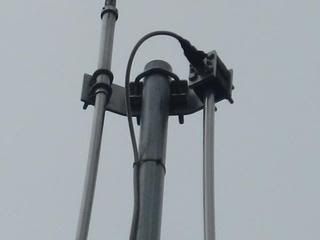Homer, this is going to get confusing. I can't remember if I posted models showing the results of changing the bow on the A/P, but I know we talked about it. The patent and common idea is that such adjustments to the bow in the radials changes the impedance, and can also change the elevation for the maximum angle. It makes sense that we can see change in match and resonance by testing, but we really can't tell changes in the gain and angle...even if it does change.
These models do show the similar moves as you made changing the bow, but they do not change the strap position on the radials. I changed the strap length, and it appears to be changing the impedance, but I see it as an obvious change in frequency, just like you described using your 259B. When that happened we didn't talk about the match so much, we discussed the frequency and that is what your meter was showing us.
This said, right or wrong, these adjustments do not indicate any change in pattern's best low angle lobe, the part we can't easily see or likely tell for sure...in our real world testing.
I see the narrowing of these radials as improving the match to its best compared and including the 12.5" dimension for my "to spec" model and the 22" wide spaced model which I think was supposed to send the angle down well below the horizon.
In this regard, I don't remember what your actual matching changes were using your 259B I was considering only frequency and resonance I think. This issue of match vs. resonance can get confusing trying to understand and prove what causes what. I have mixed feelings on what I've done here, and I didn't realize it until I started writing about how and what I saw.
Non-the-less, here are the overlays for the three models detailed below.

First model is my "to spec" model that has the strap dimension, 12.5", the same as my Top One A/P model.
Second model the strap is only adjusted to simulate the radials are 10" apart.
Third model the strap is only adjusted to simulate the radials are 22" apart.
These changes were all made at the same point on the antenna and this did not move the strap, the strap length was changed, see further explanation below.
View attachment AstroPlane tuned with radials space.pdf
Note: I considered the fact that my adjustments were all made at the same height on my model, and maybe that is what the patent is saying instead of moving the strap change the bow. Per se my strap did not move, but the bow did change for this example. Did Avanti tell us that the location of the bow was what was important or did the tell us the bow is what made the difference? At this point I'm a bit confused and I might have to do a lot more work to physically move the strap up or down keeping the strap the same size as I go.
I did the models this way, because Eznec will not let me make anything but a straight line or a loop of some dimension, but the loops are made using very small straight lines to simulate the arc, so I'm still limited to straight lines. The arc on the A/P radials has to be done using two wire for each side of the antenna as a result in creating the bow, albeit they are the same diameter wires.
The real antenna is not made adjustable in this area, but Homer your's is, so you move the strap to change the bow, but is this what Avanti was talking about or were they telling us the bow was what mattered and they put it at the best spot in their product.
I was thinking the bow was what made the difference and such an adjustment was easy with the model by changing the strap length. I might have to consider that the length of the two radials, bottom and top if I want to make changes as you moved your strap. I discounted this idea, because the elements are the same size and the moves are small, like 1" at a time just change the bow a little. Your antenna was left with the same total length of each radial and so is my model.
Homer if you understand the is issue as I have attempted to describe, then maybe you or others might consider if it's an issue or not, and let me know what you think.
Is the strap on your A/P adjustable?
Personally, I think working with this model...it would be a lot easier to change frequency adjusting the top hat. However, I haven't studied the effects on the match, gain and angle if any...by doing that. I know it will change frequency if we wanted.
The A/P has a lot of good matching bandwidth to work with.


